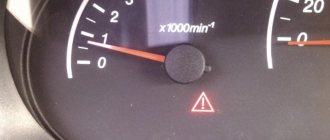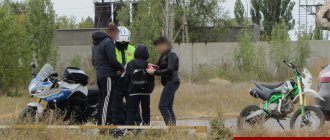We will be interested now in the sign prohibiting parking. There are quite a few interpretations of it. And for each case there is a separate image. Of course, there are some penalties for parking violations. But which ones exactly? What does a sign prohibiting parking look like in one case or another? All this is necessary to know. After all, this is the only way to avoid punishment and the dire consequences of committed violations. Let's try to make sense of all this. There is no need to be scared - everything is extremely simple to understand. The main thing is to know your rights and traffic rules.
Definitions
Let's start with definitions. The thing is that in the traffic rules there are signs prohibiting parking, and those that do not allow stopping. These are all different concepts, but the penalties for these violations are approximately the same.
Before examining a no-parking sign, it’s worth understanding the definitions. What is what? According to the law, a stop is a temporary and intentional interruption of the movement of a car (or vehicle) for up to 5 minutes. This definition is used in cases where the action is necessary for boarding and disembarking passengers, as well as unloading and loading.
But parking is a broader concept. It characterizes a long stop (more than 5 minutes) not associated with passengers or loading. At the same time, the driver does everything consciously and deliberately. As you can see, there is nothing difficult to understand here. The sign prohibiting parking has several interpretations. Which ones?
Passenger disembarkation
There are a number of contradictions in the traffic rules that cannot be implemented simultaneously. It is difficult to find the differences between deliberately stopping and stopping the movement of a vehicle. Based on these data, we can answer the question, how many minutes can you stand under the sign? It is believed that 5 minutes should be enough . The same time is allocated for unloading the car in case of emergency. Most often, a stop is made to perform precisely these actions. However, the ban on its implementation has always existed under the appropriate sign. That is why it is best to avoid creating such unpleasant situations. It is difficult to unambiguously determine the employee’s reaction not to the circumstances that prompted him to stop the car.
Additionally, we note that in judicial practice there is a conclusion that the driver of a public vehicle transporting passengers with their embarkation and disembarkation in any non-prohibited place along a regular transportation route that does not provide designated stopping places must comply with the general traffic rules, including including the requirement of road sign 3.27.
Decision of the Moscow City Court of December 16, 2021 in case No. 7-16294/2019
Decision of the Moscow City Court of March 4, 2021 in case No. 7-2140/2019
We also note that the Supreme Court of the Russian Federation did not make an exception for taxi drivers and did not allow them to drop off or wait for passengers under the “no stopping” sign. A Moscow driver filed a complaint with the highest authority, indicating that he has a license to transport people, which means his car can be equated to public transport (Resolution of the Supreme Court of the Russian Federation dated August 12, 2021 N 5-AD16-91).
Parking
There is another popular type of prohibition sign. This is "No Parking". It is somewhat reminiscent of the previous version, but has a difference. Which one exactly?
“No parking” is a circle with a red edge crossed out just once diagonally from left to right. At the same time, this sign does not prohibit stopping. Near it you can “pause” for 5 minutes to unload and load something, as well as disembark and pick up passengers. Everything is easy and simple, isn't it?
Description and history
The road sign has a round shape, a blue background with a red border around the circumference and red stripes intersecting at an angle of 90 degrees - a kind of cross. Thanks to this coloring (valid since 2013), the sign is clearly visible even from afar.
In its familiar form today, this road definition appeared in 1973 after the introduction of the standard on the territory of the Soviet Union. Before this event, the specified road sign was decorated in yellow colors. The rules have been and continue to be regularly amended, but after 2013 they have not yet addressed issues related to this sign. But the size of fines (administrative liability), to the chagrin of those who are not friends with the law, has increased significantly since 2013.
Addition
Please note that very often there are some additional signs on poles with installed signs. They play an important role in traffic rules. Their task is to clarify certain points.
For example, a sign prohibiting truck parking is “No Stopping,” with an additional small picture of a truck underneath it. Please pay attention to this feature. After all, very often prohibition signs have certain clarifications. And, of course, the coverage area. Which one? We will talk about this now.
Coverage area
Let's consider the most common and simplest scenario. If there are no clarifications, then any road sign has its own coverage area. What restrictions might there be?
A sign prohibiting parking (the coverage area of which is not specified) is valid only for the lane of the roadway on which it is installed. More precisely, on the side where it stands. And parking in this case extends to the nearest intersection (in a populated area). If there are none, then until the very end. Nothing difficult, right?
It turns out that if you “run into” “Stopping is prohibited”, then you cannot park at least to the nearest intersection. Please take this into account. Although there are some limitations and features that we have not talked about yet. But now we have to fix this.
If there are no other signs and signs
We have selected something even more interesting for you: New road signs and their meaning
If there is no sign or road marking next to the sign, then the order applies to the first intersection with another street and road. Of course, exits into courtyards and paths do not count. In order not to doubt whether the intersection sign has been canceled or you still cannot stop, you should refer to the traffic rules, where this point is clearly stated.
The text of the Appendix states that the effect of the no-stop sign cannot be canceled:
- departures from adjacent territories;
- intersections with roads leading to fields or forests;
- any intersections with secondary roads that do not have a main road sign in front of them.
The ban is canceled when the motorist leaves the city or other populated area where the ban has been established, or enters the populated area after passing the prohibitory sign. If there is both an intersection and a populated area on the way, then the ban is canceled by whichever the driver reaches first.
How to understand that a settlement has begun or ended
The fact that the village or city is already behind is indicated not by the driver’s impression, but by road signs. Even if the last houses have already disappeared over the horizon, this does not mean that you can leave your car here. Likewise, a driver should not be confused by shopping centers and pedestrians if he has passed a sign informing him that he has left a populated area.
The beginning of a settlement is indicated by a road sign with its name on a white rectangle. Next to the name there may be silhouettes of houses. Departure from a populated area is indicated in the same way, only its name will be crossed out.
Important: you should carefully follow the signs on the road. Often, immediately after leaving a village or city, there is another “No Parking” road sign and, despite the cancellation of the previous one, you still won’t be able to park.
Arrow to down
Clarifying signs very often indicate the coverage area of the main sign. And in our case, you can easily get confused. Please note that a no-parking sign with an arrow pointing down is quite common on roads. But what does he “represent”?
As practice shows (and the law states), this kind of image indicates the end of the sign’s validity. That is, you can already park behind it. And nothing will happen to you with such actions. But it’s better not to stop in front of the sign. After all, the coverage area has not ended yet. In principle, there is nothing difficult to understand. Did you see a down arrow under “Stopping prohibited” (in a separate sign)? Then know that you can park behind this sign. The restricted area is ending.
Double arrow
But that is not all. Many drivers, especially beginners, can become confused by traffic signs. And in clarifying interpretations too. For example, what does a no-parking sign depict with an arrow down and an up arrow?
We have already dealt with one “arrow”. This is an action limitation. What about the double then? In this case, there is no need to panic. The only thing worth considering is that this kind of sign shows us that it is within the coverage area of the main sign. That is, it prohibits parking in a certain area before and after the pole. Nothing difficult. Typically on the same side you will see a “No Stopping” with a down arrow. These are very common cases. Therefore, there is no need to be afraid or afraid of the double arrow. It is needed to prevent stops in a certain area. Quite often there is a specific small clarifying symbol in the form of meters. It indicates the parking restriction area after and before the sign.
What does a square speed sign on a blue background mean?
Now let's move on to the second part of our article and look at another high-speed road sign on a blue background. Its action is much simpler and does not bear any responsibility for violation, because it is impossible to violate it.
We are talking about sign 6.2 - this is a square canvas with a blue background and a white speed value. And it is advisory in nature - it indicates that on the section of road immediately behind it it is better to adhere to the speed indicated on the sign.
This is what sign 6.2 looks like, which only recommends sticking to the speed indicated on it.
It is often used in conjunction with warning signs. For example, about a dangerous section of the road, about wild animals, a slippery road or a slope (descent).
How fast can you go?
With anyone. As we mentioned above, it does not set any restrictions and refers to informational road signs.
However, it should be borne in mind that driving at a speed higher than indicated on it can become an indirect cause of an accident. And when considering a case in court and determining guilt, a judge or official may consider driving at a different speed than recommended for a given section of the road as an aggravating factor.
What is the coverage area?
In this case, this is partially described in the traffic rules, as well as in GOST 52289-2019, paragraph 5.7.3. In general cases, 6.2 applies to the nearest intersection. However, if it is installed with a warning sign, then until the end of the dangerous section - this is exactly what is written in the Rules, which causes some misunderstanding of the official interpretation.
The fact is that this square blue sign can be installed together with any warning sign (triangular with a red frame). However, its coverage area is indicated - until the end of the dangerous section. And there is a warning sign of the same name about a dangerous area - with an exclamation mark drawn on it. What is meant in this case is not entirely clear. On the one hand, if 6.2 is standing on the road together with, for example, a “Road Works” sign, then it is clear that there is a dangerous section ahead. But it is not clear whether the coverage area of the recommended driving speed is limited to the end of the road work site or to the nearest intersection...
In any case, however, there is clause 10.1 in the traffic rules, which specifies to move at such a speed that will ensure compliance with the Rules and make it possible to avoid danger.
In addition, the square sign of the recommended speed can also be with a plate 8.2.3 coverage area (clause 5.9.5 of the same GOST).
What is the fine for violating a sign?
It does not exist and cannot exist. This is so because sign 6.2 is of an informational (advisory) nature and does not contain any requirements, prohibitions and/or instructions.
And without violating the traffic rules, there can be no traffic fine.
Something else useful for you:
- Changes in traffic rules in March 2021: new road sign 6.22 Photo and video recording
- Can a driver's license be revoked for speeding? For what, according to cameras and how to get a fine?
- Is it necessary to comply with reduced traffic signs?
Time
And that's not all. Sometimes you can find quite non-standard parking restrictions on the streets. For example, a sign prohibiting parking, indicating the time. To be honest, everything is quite simple here. The driver does not have the right to stop near the sign and after it within a certain period of time.
Which one? This will be indicated by a clarifying sign below under the main image. Most often, such restrictions are imposed in busy areas of cities. And you must anticipate this. At times not indicated on the table, you can park in certain places. Although some drivers still do not risk doing this. Only in rare cases, when it is really necessary. It’s better to play it safe once again than to run into this or that punishment.
Nuances of the restriction
In practice, quite often one can encounter contradictory situations. For example, immediately after the sign there may be a stop where unloading and boarding take place. Based on this, we can conclude that stopping to disembark passengers is considered acceptable. This fact is indicated in the traffic rules. However, not all drivers decide to take unnecessary risks.
Important! If there is a need to stop the car to disembark passengers, it is better to do this immediately in front of the sign itself.
Only in this case can the driver be completely sure that they have no right to try to collect a fine from him.
A person will not become a violator if he strictly follows all traffic rules. “No stopping” is an important sign. Compliance with it indicates the politeness of the driver. Thanks to this, it is possible to make traffic on the roads safer and more comfortable.
Even days
Another rather interesting case is the sign prohibiting parking on even days. It does not occur very often in small cities, but in large cities all the time. Moreover, it does not apply to taxis, fixed-route transport, or cars driven by disabled people. In all other cases you will have to follow the rules.
What does this sign look like? This is “No Parking”, but inside the circle there will be two white “bricks” located vertically. And they will be crossed out. As you can see, nothing supernatural either. If you see this sign, you can be sure that you cannot stop here on even days in the month. The rest of the time this rule does not apply. And each driver can “pause” in the area near the sign. This is worth taking into account.
Odd days
There is also a sign prohibiting parking on odd days. And it doesn't look particularly original. It is somewhat reminiscent of a sign prohibiting parking on even days of the month.
What exactly does the next type of ban look like? This is nothing more than “No Parking”, but there is one “brick” in the center. In a vertical position and under the diagonal line of the circle. That is, it is crossed out. That's all.
The restrictions in this case are exactly the same as in the previous case - parking is prohibited to all citizens with the exception of the post office, minibuses (transport), as well as the disabled. You can park on even days. If there are any clarifications under the index, pay attention to them. It happens that on both even and odd days, parking is prohibited only at certain times. This is a fairly common phenomenon that drivers rarely pay attention to.
What fines are provided for car offenders?
In megacities with difficult road conditions and other populated areas, parking a car under a sign prohibiting parking can cost a motorist one and a half thousand rubles, in the capital of the Russian Federation and St. Petersburg - up to three thousand rubles.
In Russian cities overloaded with transport, such penalties are simply necessary. Parking and unnecessary stops in areas not intended for this purpose significantly impede traffic on city roads. Registration of fines for the committed act is possible through photo and video recording.
The difficult situation with parking spaces and places for parking vehicles is relevant not only for the capital region, but also for small settlements in the Russian Federation. Ignoring prohibition signs causes a lot of trouble for law-abiding drivers and pedestrians. Large fines provided for such offenses hit the pockets of car offenders, but many of them simply do not know why the prohibition signs are installed and what they mean. Every driver should know the parking rules, no matter whether he is a beginner or an experienced driver.
Post Views: 57
Punishments
So you and I have studied the sign prohibiting parking. In general, there are many more additional clarifying symbols that specify the action of it. But the most popular of them are now no secret to us.
Violating parking and stopping rules can result in punishment. It will not always be serious, but this feature will have to be taken into account. And, as practice shows, special attention is paid to places specially equipped for parking.
The nature of punishments varies. Firstly, it all depends on the region where you live. If you live in a federal area, it will be stricter. And in ordinary cities it’s softer. Secondly, your history of “relations with the law” will also play a certain role in case of a particular violation. And this is a pretty important factor. Thirdly, a lot depends on the situation as a whole.
Practice shows that the most harmless punishment is a reprimand in the form of a warning. In second place are fines. If you decide to deal with the problem immediately, you can hope to deposit only 500 rubles. Otherwise, depending on the severity of the violation and the specific situation, you will have to pay from 1,000 to 5,000 rubles. The most unpleasant moment is the deprivation of a driver's license and confiscation of the car. In such circumstances, you will need to additionally buy your vehicle from the impound lot.
When it comes to violations of parking rules in specially designated areas, government officials talk to drivers in a more harsh manner. If you take the place of a disabled person, be sure that you will either be deprived of your rights (a very common punishment), or your car will be confiscated (also not that uncommon), or you will have to pay a hefty fine of approximately 5,000 rubles. It is unlikely that you will be able to get away with a simple warning. Always pay attention to traffic signs and obey parking rules. Remember about the restricted areas, and then you will not have any problems with the law. A sign prohibiting parking (photos of different interpretations can be seen above) will tell the driver how to act in a certain situation.
Interpretation of a road sign
Sometimes motorists are annoyed when they see that stopping is prohibited. Nothing is done for nothing, especially in approved traffic rules, including those as amended since 2013. This means that on these sections of the road, a stopped vehicle can become a serious obstacle, creating emergency situations when drivers of other vehicles will be forced to break the rules when passing (for example, in areas with busy traffic, on too narrow roads, if there is a sharp turn ahead).
In places indicated by this sign, not only stopping, but also parking (or parking) of vehicles is prohibited.
In more detail, before or behind the sign it is prohibited:
- a planned stop of a vehicle for a duration longer than that required for exiting or boarding passengers, loading or unloading cargo, and, of course, parking or parking;
- any previously planned stop lasting more than 5 minutes.
In this case, a forced stop or parking is possible if the vehicle breaks down or the driver feels unwell, as well as for other similar reasons. In this case, the driver must turn on the hazard warning lights. You will also need to post an emergency stop sign on the road. If all these conditions are met, traffic police officers will not record a violation.
An exception is also provided for stopping route vehicles. These categories of road users are allowed to stop in places specially designated for them to stop, but not in front of them.
At the same time, there is no provision for imposing a fine for stopping cars driven by disabled people if the sign is supplemented with the appropriate plate (8.18) - a wheelchair is graphically displayed, crossed out with a red line.
Also, the driver should not pay attention to the installed road sign prohibiting stopping if a representative of the traffic police slows him down - this will not constitute a violation. So, he is obliged to stop at the place indicated to him by the traffic policeman or traffic police inspector.









